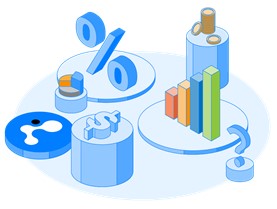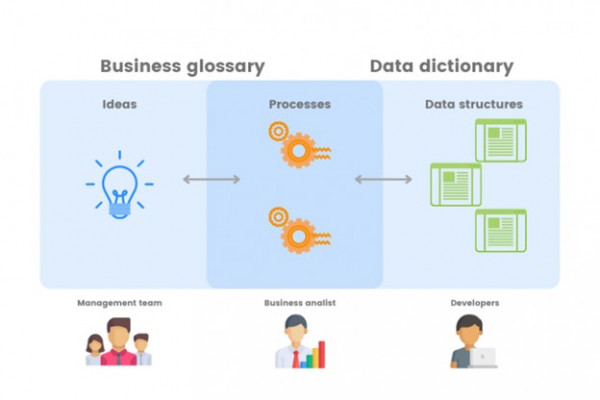Why your company needs a data dictionary
It’s a familiar headache: Rapidly compiling data in multiple formats makes it difficult to grasp how it’s built up, what it means, and how you can use it. The solution is three-sided. Create a data dictionary to catalog and describe your data, compile a business glossary to define your business terminology, and unite them to make business decisions based on accurate data insights. Below, we’ll outline what a data dictionary and business glossary can do for your company, as well as how to set them up.
Data dictionaries and business glossaries explained
Why are data dictionaries key?
A data dictionary contains detailed information on your business data. It defines your data types (such as text, whole or fractional numbers, time, and date) and explains the relationships between them, cataloging descriptions of each attribute within your data model. By creating a common vocabulary to talk about your data throughout your organization, it prevents crucial data-related actions from getting lost in translation.

Sample of a basic technical model
It’ll become your go-to basis for accuracy, consistency, and efficiency across technical documentation, inter-project communication, systems analysis, data integration, and decision-making. Eliminating wasted time and miscommunication while facilitating better working relationships and business results.
By organizing information about your data that may otherwise spread over multiple locations, a data dictionary also enables you to create a single source of truth. This makes your analysts’ lives easier as they can understand what’s in your underlying databases without delving into every column (which is at best time-consuming, at worst a human error risk).
How to set up your data dictionary

Creating a spreadsheet is an easy way to get one up and running. List each attribute (field) within your data model as a row and assign each column to information that’s helpful to know about your attributes. Examples include:
- Attribute name: Uniquely identifies the attribute, normally using your business language
- Optional/obligatory: Shows whether an attribute needs specific information before the data can be saved
- Attribute type: Confirms which data types are permitted for each attribute (perhaps integers, text, time and date, or booleans)
- Information source: The source reference for the information added about each attribute
- Attribute location: The source location for the attribute within your business database
However, a spreadsheet should only be the start of developing your data dictionary. This is due to two key pitfalls: It’s difficult to collaborate in this basic format and it’s even harder to ensure it reflects the current version of your constantly evolving data model.
What does a business glossary do?
A business glossary defines your business terminology to ensure that everyone within your organization is on the same page when they use your business terms.
For example, one team in your company could interpret “client data” with a B2B focus, as another organization’s name and commercial registration number. Another team could interpret “client data” from a B2C angle, as an individual’s username, password, bank account, and so on. Thorny issues could quickly arise if different teams interpret “client” differently — unless a business glossary preempts this.

A business glossary avoids misinterpretation, ensures accurate analytics, and can boost collaboration, understanding, and trust between your employees. It’s also key for data governance and regulatory compliance, supporting you to gather, process, and report on your data coherently and comprehensively.
Setting up your business glossary
Again, a spreadsheet is a useful template for your business glossary. By listing your business terms alongside their definitions, you’ll generate a shared vocabulary that keeps thinking and communication aligned company-wide.
Uniting your data dictionary and business glossary for actionable data
The key to providing your employees with accurate, actionable data is unifying your data dictionary with your business glossary. Whether you’re working with developed or fledgling versions of these company assets, the fundamental link between them already exists: Your business processes.
Employees working from a high-level business perspective within your company likely won’t be familiar with the technical ins and outs of its data sets. However, data-driven decision-making means they need to be able to correctly interpret the overall data picture. That’s where the data dictionary comes in.
From a developer standpoint, it’s the reverse. To contextualize the tables, columns, and functions they’re working with, they need to understand the business processes behind them. A business glossary enables them to make sense of business-focused documentation to inform their data-centric work.
In the middle, we find the business analysts working with the entities and relationships involved in your business processes. The data dictionary and business glossary combined is their holy grail, creating a living link between business data and business development.
Let’s take aviation as a quick example. While analyzing the structure of a flight statistics log, you notice that the “flights” aggregate column contains fractional numbers. Out of the business context, a fractional number of flights makes no sense: How can 1.5 flights occur? Based on logic alone, a developer or analyst could easily assume an error in the data model. Yet a business glossary would explain that “1 flight” means one arrival and one departure by the same plane in the same 24-hour period. “0.5 flights” means just an arrival, or just a departure. A data dictionary would confirm the possibility of fractional numbers for that attribute. Hyperlinks directing the reader between the relevant sections in both reference files would bring us full circle — and if there were mismodel anomalies, they’d be rapidly rooted out.
Being a data-driven organization is all about this connectivity. As the foundations of mutual understanding, your data dictionary and business glossary unite to remove and prevent business roadblocks.
The future of data dictionaries and business glossaries
Remote teams are on the rise, the data sources companies rely on are diversifying, and data is increasingly at the center of every business process. As a result, the need for organizations to structure, make sense of, and effectively communicate about their data is a no-brainer.
Ensuring compliance with data regulations, though, is potentially the most vital benefit of the data dictionary-business glossary powerhouse. With a data dictionary in place, you’re able to classify each attribute in your model as GDPR-sensitive, or not. As a result, the relevant protection for the attribute can be set up in your database. Your business glossary simultaneously ensures everyone in your company can verify the who, where, and how of your business processes, ensuring data is only shared following best practices.
The dictionary-glossary duo is the most efficient route to worry-free data compliance, paving your data-driven path ahead.
Reactie toevoegen